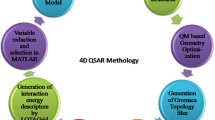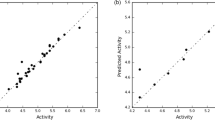Abstract
A computation model has been developed for the rational design of bioactive pharmacophore sites as anti-viral candidates based on available X-ray structures of drugs. The compounds have been previously screened for anti-viral activity against HIV-Integrase (HIV IN). Amongst the series, the most potent compounds, 4k and 4d (low μM IC50) were tested in viral cultures for their ability to present potentials (O δ−1 –O δ−2 –O δ−3 ) for anti-viral pharmacophore site but represent a potential risk of toxicity. Furthermore, the compounds 4k and 4d showed potent anti-HIV IN activity. A good correlation was obtained between the theoretical predictions of bioavailability using POM suite (Petra/Osiris/Molinspiration containing Lipinski’s rule-of-five) and experimental verification. The structure–activity relationships were also analyzed to vindicate the POM results.
Graphical abstract
A series of known anti-HIV agents; the amide-containing diketoacids were POM and 3D-QSAR analyzed in goal to understand and develop more potent/selective HIV IN inhibitors. Their inhibition of HIV IN was attributed to them containing O1,O2,O4-pharmacophore site. The structure–activity relationships were discussed on the basis of POM analyses.







Similar content being viewed by others
References
Al Houari G, Kerbal A, Bennani B, Baba MF, Daoudi M, Hadda TB (2008) Drug design of new antitubercular agents: 1,3-dipolar cycloaddition reaction of arylnitriloxides and 3-para-methoxy-benzylidene-isochroman-4-ones. Arkivoc xi:56–63
Anaflous A, Benchat N, Mimouni M, Abouricha S, Hadda TB, El-Bali B, Hakkou A, Hacht B (2004) Armed imidazo [1,2-a] pyrimidines (pyridines): evaluation of Antibacterial activity. Lett Drug Des Discov 1:224–229
Bennani B, Kerbal A, Daoudi M, Baba BF, Al Houari G, Jalbout AF, Mimouni M, Benazza M, Demailly G, Akkurt M, Yýldýrým SO, Hadda TB (2007) Combined drug design of potential Mycobacterium tuberculosis and HIV-1 inhibitors: 3′,4′-di-substituted-4′H-spiro[isothiochromene-3,5′-isoxazol]-4(1H)-ones. Arkivoc xvi:19–40
Chohan ZH, Youssoufi MH, Jarrahpour A, Hadda TB (2010a) Identification of antibacterial and antifungal pharmacophore sites for potent bacteria and fungi inhibition: indolenyl sulfonamide derivatives. Eur J Med Chem 45(3):1189–1199
Chohan ZH, Sumrra SH, Youssoufi MH, Hadd TB (2010b) Metal based biologically active compounds: design, synthesis and antibacterial/antifungal/cytotoxic properties of triazole derived schiff bases and their oxovanadium(IV) complexes. Eur J Med Chem 45(7):2739–2747
Dubey S, Satyanarayana YD, Lavania H (2007) Development of integrase inhibitors for treatment of AIDS: an overview. Eur J Med Chem 42(9):1159–1168
Ertl P, Rohde B, Selzer P (2000) Fast calculation of molecular Polar Surface Area (PSA) as a sum of fragment-based contributions and its application to the prediction of drug transport properties. J Med Chem 43(20):3714–3717
Fathi J, Masand V, Jawarkar R, Mouhoub R, Hadda TB (2011) POM as efficient tools to predict and improve both antibacterial and antifungal activity of aryl aldazines. J Comput Method Mol Des 1(3):57–68
Garvey EP, Johns BA, Gartland MJ, Foster SA, Miller WH, Ferris RG, Hazen RJ, Underwood MR, Boros EE, Thompson JB, Weatherhead JG, Koble CS, Allen SH, Schaller LT, Sherrill RG, Yoshinaga T, Kobayashi M, Wakasa-Morimoto C, Miki S, Nakahara K, Noshi T, Sato A, Fujiwara T (2008) The naphthyridinone GSK364735 is a novel, potent human immunodeficiency virus type 1 integrase inhibitor and antiretroviral. Antimicrob Agents Chemother 52(3):901–908
Grobler JA, Stillmock K, Hu B, Witmer M, Fetlock P, Espeseth AS, Wolfe A, Egbertson M, Bourgeois M, Melamed J, Wai JS, Young S, Vacca J, Hazuda DJ (2002) Diketo acid inhibitor mechanism and HIV-1 integrase: implications for metal binding in the active site of phosphotransferase enzymes. Proc Natl Acad Sci USA 99:6661–6666
Hadda TB, Kotchevar AT, Daoudi M, Bennani B, Larbi NB, Kerbal A (2005) Anti-tumour activity of some polydentate N-ligands: N,N-bis-(3-substituted-5-methylpyrazol-1yl methyl) arylamines and N,N,N′,N′-tetra-[(3-substituted-5-methyl pyrazol-1yl] para-phenylenediamines. Lett Drug Des Discov 2(8):584–589
Hadda TB, Badri R, Kerbal A, Filali Baba B, Akkurt M, Demailly G, Benazza M (2007) Synthesis and antitubercular activity of spiroheterocycles: 2,2′,4′,5′-tetra-substituted-1,2,2′,4′-tetrahydro-4H-spiro[isoquinoline-3,3′-pyrazol]-4-ones. Arkivoc xiv:276–288
Hadda TB, Rahima B, Kerbal A, Filali Baba B, Akkurt M, Demailly G, Benazza M (2008) Looking for a new antitubercular pharmacophore site: synthesis and bioactivity of spiroheterocycles 2,3′,4′-tri-substituted-1,2-dihydro-4H,4′H-spiro [iso-quinoline-3,5′-isoxazol]-4-ones. Arkivoc ii:1–13
Hakkou A, Bouakka M, Touzani R, Elkadiri S, Ramdani A, Kotchevar A, Ellis T, Waring M, Hadda TB (2002) 2,3-Bifunctionalized quinoxalines: synthesis, DNA interactions and evaluation of anticancer, antituberculosis and antifungal activity. Molecules 7(8):641–656
Jarrahpour A, Fathi J, Mimouni M, Hadda TB, Sheikh J, Chohan ZH, Parvez A (2011) Petra, Osiris and Molinspiration (POM) together as a successful support in drug design: antibacterial activity and biopharmaceutical characterization of some azo Schiff bases. Med Chem Res 19:1–7. doi:10.1007/s00044-011-9723-0
Jawarkar RD, Masand VH, Patil KN, Mahajan DT, Youssoufi MH, Hadda TB, Kumbhare SL (2010) 3D-QSAR study on coumarin analogues as potent inhibitors of MAO-B using a COMFA approach. Pharm Chem 2(6):302–310
Johns BA, Boros EE, Kawasuji T, Koble CS, Kurose N, Murai H, Sherrill RG, Weatherhead JG (2004) HIV integrase inhibitors. Patent WO 2005/077050 A2
Kawasuji T, Fuji M, Yoshinaga T, Sato A, Fujiwara T, Kiyama R (2006a) A platform for designing HIV integrase inhibitors. Part 2. A two-metal binding model as a potential mechanism of HIV integrase inhibitors. Bioorg Med Chem 14(24):8420–8429
Kawasuji T, Yoshinaga T, Sato A, Yodo M, Fujiwara T, Kiyama R (2006b) A platform for designing HIV integrase inhibitors. Part 1. 2-Hydroxy-3-heteroaryl acrylic acid derivatives as novel HIV integrase inhibitors and modeling of hydrophilic and hydrophobic pharmacophores. Bioorg Med Chem 14(24):8430–8445
Lee Y-C (2009) Thesis: studies towards the development of novel HIV-1 integrase inhibitors. Rhodes University, Grahamstown
Lia H, Wang C, Sanchez T, Tan Y, Jiang C, Neamati N, Zhao G (2009) Amide-containing diketoacids as HIV-1 integrase inhibitors: synthesis, structure–activity relationship analysis, and biological activity. Bioorg Med Chem 17(7):2913–2919
Masand VH, Jawarkar RD, Patil KN, Mahajan DT, Hadda TB, Kurhade GH (2010a) COMFA analysis and toxicity risk assessment of coumarin analogues as Mao-A inhibitors: attempting better insight in drug design. Pharm Lett 2(6):350–357
Masand VH, Jawarkar RD, Patil KN, Nazerruddin GM, Bajaj SO (2010b) Correlation potential of Wiener index vis-à-vis molecular refractivity; Antimalarial activity of xanthone derivatives. Org Chem Indian J 6(1):30–38
Masand VH, Jawarkar RD, Patil KN, Hadda TB, Alafeefy AA, Youssoufi MH (2011a) Exploring interactions of 2-Amino-6-arylsulfonylbenzonitrile derivatives as non- nucleoside reverse transcriptase inhibitors of HIV-1 using docking studies. J Comput Method Mol Des 1(3):39–48
Masand VH, Jawarkar RD, Mahajan DT, Hadda TB, Manikrao AM, Khatale PN, Vyas JV (2011b) Presuming the Probable Anti-inflammatory Mechanism of Ursolic Acid: a plant derived pentacyclic triterpenoid, using molecular docking. J Comput Method Mol Des 1(2):9–13
Masand VH, Jawarkar RD, Mahajan DT, Hadda TB, Sheikh J, Patil KN (2011) QSAR and COMFA studies of biphenyl analogs of the anti-tuberculosis drug (6S)-2-nitro-6-{[4-(trifluoromethoxy)benzyl]oxy}-6,7-dihydro-5H-imidazo[2,1-b][1,3]oxazine(PA-824), Med Chem Res. doi:10.1007/s00044-011-9787-x
Masand VH, Mahajan DT, Patil KN, Padole N, Hadda TB, Alafeefy AA, Shibi IG (2011d) Molecular docking and 3D QSAR studies of quinoxaline derivatives as potential influenza NS1A protein inhibitors. J Comput Method Mol Des 1(3):49–56
Masand VH, Mahajan DT, Patil KN, Chinchkhede KD, Jawarkar RD, Hadda TB, Alafeefy AA, Shibi IG (2012) k-NN, quantum mechanical and field similarity based analysis of xanthone derivatives as α-glucosidase inhibitors, Med Chem Res 1–12. doi:10.1007/s00044-012-9995-z
Mouscadet J-F, Delelis O, Marcelin A-G, Tchertanov L (2010) Resistance to HIV-1 integrase inhibitors: a structural perspective. Drug Resist Update 13(4–5):139–150
Nowotny M, Yang W (2006) Stepwise analyses of metal ions in RNase H catalysis from substrate destabilization to product release. EMBO J 25(9):1924–1933
Parvez A, Meshram J, Youssoufi MH, Hadda TB (2010a) Theoretical calculations and experimental verification of the antibacterial potential of some monocyclic beta-lactams containing two synergetic buried antibacterial pharmacophore sites. Phosphorus Sulfur Silicon Relat Elem 7:1500–1510
Parvez A, Meshram J, Youssoufi MH, Hadda TB (2010b) Bioinformatic prediction and experimental verification of antibacterial potential of some monocyclic β-lactams containing two synergetic buried antibacterial pharmacophore sites (Part II). Phosphorus Sulfur Silicon Relat Elem 185:1500–1510
Parvez A, Meshram J, Hadda TB (2011) POM validation and structure based drug design: a novel transpeptidase inhibitor with least bacterial resistance. International conference on chemistry for mankind: innovative ideas in life sciences. ICCM-2011, Nagpur, India, 9–11 Feb. http://www.iccm2011-rtmnu.org/
Savarino A (2007) In silico docking of HIV-1 integrase inhibitors reveals a novel drug type acting on an enzyme/DNA reaction intermediate. Retrovirology 4:21. doi:10.1186/1742-4690-4-21
Sheikh J, Juneja H, Ingle V, Ali P, Hadda TB (2011) Synthesis and in vitro biology of Co(II), Ni(II), Cu(II) and Zinc(II) complexes of functionalized beta-diketone bearing energy buried potential antibacterial and antiviral O,O-pharmacophore sites. J Saudi Chem Soc. doi:10.1016/j.jscs.2011.04.004
Zunino F, Kotchevar AT, Waring M, Daoudi M, Ben Larbi N, Mimouni M, Sam N, Hadda TB (2002) Novel cytotoxic oxopyridoindolizines: iso-propyl-7,8,9-tri-chloro-6,7,8,9-tetra-hydro-5-oxo-pyrido[2,3-a]indolizine-10-carboxylates. Molecules 7(8):628–640. doi:10.3390/70800628
Acknowledgments
The authors thank the Mohammed First University Research Council for financial support (Grant Ref.: PGR-BH). Prof. T. Ben Hadda would like to thank ACTELION; the Biopharmaceutical Company of Swiss, for the on-line molecular properties calculations.
Author information
Authors and Affiliations
Corresponding authors
Rights and permissions
About this article
Cite this article
Hadda, T.B., Fathi, J., Chafchaouni, I. et al. Computational POM and 3D-QSAR evaluation of experimental in vitro HIV-1-Integrase inhibition of amide-containing diketoacids. Med Chem Res 22, 1456–1464 (2013). https://doi.org/10.1007/s00044-012-0120-0
Received:
Accepted:
Published:
Issue Date:
DOI: https://doi.org/10.1007/s00044-012-0120-0




